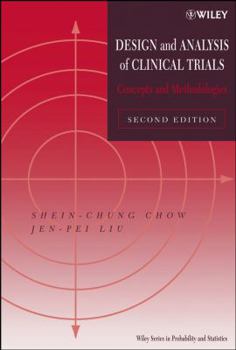Design and Analysis of Clinical Trials: Concepts and Methodologies
Select Format
Select Condition 
Book Overview
Praise for the First Edition of Design and Analysis of Clinical Trials "An excellent book, providing a discussion of the clinical trial process from designing the study through analyzing the data, and to regulatory requirement . . . could easily be used as a classroom text to understand the process in the new drug development area." - Statistical Methods in Medicine A complete and balanced presentation now revised, updated, and expanded As the field of research possibilities expands, the need for a working understanding of how to carry out clinical trials only increases. New developments in the theory and practice of clinical research include a growing body of literature on the subject, new technologies and methodologies, and new guidelines from the International Conference on Harmonization (ICH). Design and Analysis of Clinical Trials , Second Edition provides both a comprehensive, unified presentation of principles and methodologies for various clinical trials, and a well-balanced summary of current regulatory requirements. This unique resource bridges the gap between clinical and statistical disciplines, covering both fields in a lucid and accessible manner. Thoroughly updated from its first edition, the Second Edition of Design and Analysis of Clinical Trials features new topics such as: Clinical trials and regulations, especially those of the ICH Clinical significance, reproducibility, and generalizability Goals of clinical trials and target population New study designs and trial types Sample size determination on equivalence and noninferiority trials, as well as comparing variabilities Also, three entirely new chapters cover: Designs for cancer clinical trials Preparation and implementation of a clinical protocol Data management of a clinical trial Written with the practitioner in mind, the presentation assumes only a minimal mathematical and statistical background for its reader. Instead, the writing emphasizes real-life examples and illustrations from clinical case studies, as well as numerous references-280 of them new to the Second Edition-to the literature. Design and Analysis of Clinical Trials , Second Edition will benefit academic, pharmaceutical, medical, and regulatory scientists/researchers, statisticians, and graduate-level students in these areas by serving as a useful, thorough reference source for clinical research.
Format:Hardcover
Language:English
ISBN:0471249858
ISBN13:9780471249856
Release Date:December 2003
Publisher:Wiley-Interscience
Length:752 Pages
Weight:3.25 lbs.
Dimensions:10.1" x 1.7" x 7.3"
Customer Reviews
1 rating
good practical treatment covering FDA guidelines and ICH guidelines as well
Published by Thriftbooks.com User , 17 years ago
The authors have experience conducting clinical trials in the pharmaceutical industry and this shows in their approach. All the issues that arise in an NDA submission to the FDA are covered. In the introduction the authors describe the regulatory process and the role of the FDA. They even provide organizational charts for the FDA Center for Drug Evaluation and Research. I have been working as a senior biostatistician for medical device companies for the last 5 years. Most of the trials I have worked on were regulated by the FDA and a number of issues that have been important to the FDA include (1) multiple comparisons, (2) intention-to-treat versus per protocol analysis, (3) pooling centers, (4) baseline data and demographics, (5) data monitoring and (6) safety. They are all covered in chapters 11 and 12 of this book. Chapter 10 emphasizes sample size determination and interim analyses are covered in chapter 9. Randomization and blinding are covered in chapter 4. These topics are emphasized because of their importance in regulated clinical trials. One does not find them covered very much in other statistics texts on survival analysis or clinical trials. The mathematics level is intermediate. The authors write well and incorporate the important practical interplay between the statistician, the clinician and the physician. They provide many good references. The book is a good reference for anyone interested in clinical trials. Points are illustrated through the use of real trials. Recent advances in Bayesian methods, resampling and meta analysis are not covered but most important topics are covered including group sequential methods.






